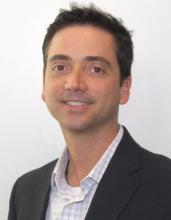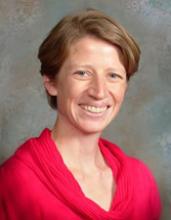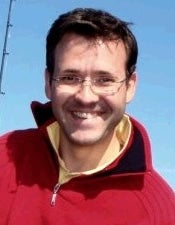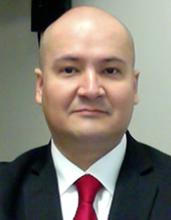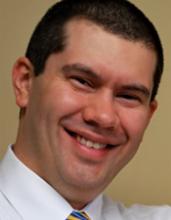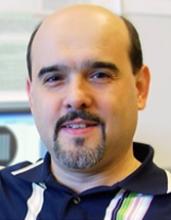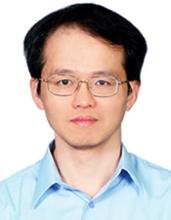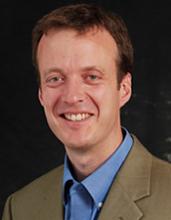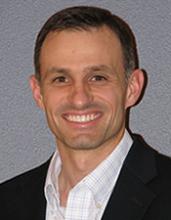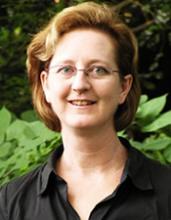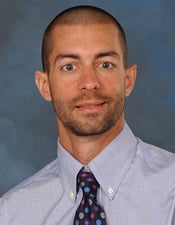Learn about the scientists and researchers who have previously been involved with the Neural Engineering Center at Case Western Reserve University. If you are an alum of our center, we encourage you to join our alumni group on LinkedIn.
Emily Graczyk, PhD
Professor
Department of Biomedical Engineering
Case Western Reserve University
Emily Graczyk, PhD, is a research associate in the Department of Biomedical Engineering at Case Western Reserve University and an investigator in the Advanced Platform Technology Center at the Cleveland VA Medical Center. She earned her BS at the University of South Carolina, Columbia and her PhD at Case Western Reserve University, both in biomedical engineering. Graczyk's research examines the coding and processing of somatosensory information and the perceptual and psychological experience of artificial sensation created by neurotechnology. She uses cross-disciplinary approaches to study sensation, including neural stimulation, computational modeling, psychometrics, behavioral assessments and qualitative analyses. During her PhD training, she was awarded a National Science Foundation Graduate Research Fellowship. She has recently secured independent funding from the Department of Defense and the Defense Advanced Research Projects Agency (DARPA) for her research projects. In 2018, Dr. Graczyk was named a DARPA Riser, one of a select group of early career investigators identified as potential future superstars whose work could impact national security.
Rafael Carbunaru, PhD
Vice President, Research & Development
Boston Scientific Neuromodulation
Rafael Carbunaru leads the Research and Development Neuromodulation Division for Boston Scientific Corporation located in Valencia, California. He is focused on developing a portfolio of neuromodulation products and technologies, and creating a culture of meaningful innovation and high performance. His team has developed breakthrough products in spinal cord stimulation for the treatment of chronic pain, deep brain stimulation for movement disorders, and advanced micro stimulation technologies.
Prior to this role, he was the research and development Director for Emerging Indications. He led the development of micro stimulation and MRI compatible technologies as well as supported clinical trials in migraine and overactive bladder, among others.
Carbunaru holds a PhD (1999) and MSc (1996) in biomedical engineering (with concentration in neurostimulation and electromagnetism) from Case Western Reserve University, under the guidance of Dominique Durand. He also has an electronics engineering degree (1993) from Universidad Simon Bolivar (Venezuela). Rafael currently holds over 50 U.S. and international patents.
His mission is to transform lives through innovative medical solutions.
Katharine H. Polasek
Assistant Professor of Engineering
Hope College
Katharine H. Polasek received a BS degree in mechanical engineering from the University of Michigan in Ann Arbor, Michigan, in 2001 and a PhD degree in biomedical engineering from Case Western Reserve University in 2007. Her graduate work focused on nerve stimulation for restoration of arm and hand function in high tetraplegia. In 2008 she received a NIH postdoctoral fellowship through the Department of Orthopedics at CWRU where she worked on nerve stimulation to provide sensory feedback to individuals with amputations. Polasek is currently an assistant professor of Engineering at Hope College in Holland, Michigan, where she established a biomedical engineering emphasis for undergraduate students. Her research interests are in neural engineering and rehabilitation for musculoskeletal and neurological disorders and she is currently developing a non-invasive therapy to treat phantom limb pain.
Manfred Franke
Senior Research Scientist
Oculeve Inc.
After receiving his MS in electrical engineering from the TU-Dresden University of Technology in Germany in 2007, Manfred Franke worked as research assistant at the Stieglitz Lab at the IMTEK, University of Freiburg. He received a Fulbright grant for his PhD proposal and came to Cleveland in 2009. He finished his PhD with Ken Gustafson and Kevin Kilgore with the university’s Doctoral Excellence Award for Biomedical Engineering in 2014 for his work on the translation of non-damaging electrical nerve blocks from research to practice. His PhD work covered four different approaches to provide nerve block without harming neural tissue: First, he implemented a fully-automated push-button system to provide bladder voiding in a chronic preclinical spinal cord injury model using sacral bladder drive and pudendal nerve kHz AC (KHFAC) block. Secondly, he developed necessary technologies to achieve clean electrical block waveforms in order to prevent unwanted damage to the nerve and small waveform generators that could run on low-voltage batteries to facilitate the implementation of such devices. His work further included charge-balanced direct current (CBDC) technology to temporarily and completely block nerve conduction. Last but not least, his research covered new approaches to provide a selective nerve activation of only small fibers (inverting the inverse recruitment) and optimized electrodes for optimal delivery of AC and DC nerve block waveforms. Franke holds 11 pending patents ranging from waveforms for neural activation and block to analogue and digital technologies for specific interaction with select neural fibers. Several of his patents are in the process of being licensed.
Franke currently works as senior research scientist at San Francisco based Oculeve Inc. to establish a better understanding of neurological pathways responsible for dry eye disease. Aside from working in research and translating technology into practice, he enjoys being internationally active as DAAD Research Ambassador, for the IAESTE ASBI and the Fulbright network.
J. Luis Luján
Assistant Professor of Neurologic Surgery and Physiology, and Biomedical Engineering
Mayo Clinic
J. Luis Luján, PhD, is currently an assistant professor in the departments of Neurologic Surgery and Physiology and Biomedical Engineering at Mayo Clinic.
Luján received a BS degree in computer and systems engineering from the Universidad Autonoma de Chihuahua, in Chihuahua, Mexico. Additionally, Luján received both an MS and PhD degree in biomedical engineering from Case Western Reserve University, under the guidance of Patrick Crago. Luján’s postdoctoral training took place at the Cleveland Clinic, in Cleveland, Ohio, under the guidance of Cameron McIntyre. In 2012, Luján joined the Mayo Clinic as an assistant professor, where he currently oversees a diverse group of researchers including graduate students, biologists, engineers, and neurosurgeons.
Luján’s research has focused on developing novel functional electrical stimulation techniques for restoring motor function following spinal cord injury. Additionally, Luján has developed novel computational and mathematical techniques for analyzing the effects of deep brain stimulation (DBS) and for improving the clinical outcomes of neuromodulation technology for the treatment of neurologic and psychiatric disorders. Luján has played a critical role in enhancing understanding of brain circuitry modulated by neurostimulation therapies for treatment of movement and psychiatric disorders, developing novel neuromodulation control paradigms, improving electrode targeting and delivery, and restoring function following neural injury and disease.
Lujan’s current research focuses on developing smart deep brain stimulation systems for patient-specific treatment of movement disorders. Additionally, Luján is working on the development of novel neurostimulation paradigms to restore motor function following spinal cord injury. Luján’s research is funded by the National Institutes of Health (R01NS084975, R21NS087320) and the Grainger Foundation.
Juan Gabriel Hincapie
Principal Research Scientist
Boston Scientific Corporation, Cardiac Rhythm Management division
Juan Gabriel Hincapie received a BS degree in electronics engineering from Universidad de los Andes, Bogotá, Colombia, in 2002 and a PhD in biomedical engineering from Case Western Reserve University in 2008, where he worked in functional electrical stimulation (FES) for restoring function in individuals with spinal cord injury at Professor Kirsch’s lab. He is now a principal research scientist at Boston Scientific Corporation, Cardiac Rhythm Management division in St Paul, Minnesota, where he is working in translating autonomic nervous system neuromodulation therapies for cardiovascular disorders such as heart failure and hypertension into clinical use.
Beth Lewandowski
Biomedical Research Engineer
NASA Glenn Research Center
Beth Lewandowski is a biomedical research engineer at the NASA Glenn Research Center in Cleveland, Ohio. She is part of the Bioscience and Technology Branch, which is within the Space Processes and Experiments Division. Lewandowski received a bachelor’s degree in electrical engineering from Cleveland State University in 1991 and an MS degree in 2003 and a PhD degree in 2009 in biomedical engineering from Case Western Reserve University. Her master’s research was conducted at the Cleveland Clinic and the topic of the research was source reconstruction of EEG signals during muscle fatigue. Her PhD dissertation topic was the generation of electrical power with an implanted piezoelectric generator using stimulated muscle activity. At NASA, Lewandowski engages in research on spaceflight induced muscle atrophy and bone loss and its impact on astronaut health, safety and performance. She utilizes ground based analog data and spaceflight data in the development of computational simulations of various mission scenarios to perform her research. Additional research interests include cognitive state monitoring of pilots using multi-modality measurements to improve aviation safety. In 2010, Lewandowski was part of the team that received NASA Glenn Research Center’s Distinguished Publication Award and she also received a NASA Space Flight Awareness Award. She is a member of the Aerospace Medical Association and IEEE. She currently lives with her husband Henry “Skip” Lewandowski in Lorain, Ohio.
Mesut Sahin
Associate Professor of Biomedical Engineering
New Jersey Institute of Technology
Mesut Sahin received his BS degree in electrical engineering from Istanbul Technical University in 1986, and MS and PhD degrees in biomedical engineering from Case Western Reserve University in 1993 and 1998. He worked with Durand on a neural prosthesis for obstructive sleep apnea and he shares a patent with him and Haxhiu on closed loop control of hypoglossal nerve stimulations on demand. After receiving his PhD, he continued his training as a postdoctoral research associate in the Neural Engineering Center at CWRU. His research interests moved to the central nervous system during post-doctoral studies and he conceived the idea of using the neural activity of descending tracts in the spinal cord as a form of spinal cord-computer interface. The project was funded by a postdoctoral fellowship from Christopher Reeve Paralysis Foundation in 1999. He joined Louisiana Tech University, Ruston, Louisiana, as an assistant professor of biomedical engineering in 2001, where he received a Whitaker Award to continue this work. In this first academic post, Sahin developed a new concept: "floating light activated micro-electrical stimulators (FLAMES) for wireless activation of the central nervous system." This project continues to be one of the major research interests in Sahin’s laboratory at New Jersey Institute of Technology, Newark, New Jersey, with support from NIH and in collaboration with Optical Characterization and Nanophotonics Laboratory at Boston University. He has been on the faculty of Biomedical Engineering at NJIT since the fall of 2005 with promotion to associate professor in 2009. For the past few years, his research interests have expanded to include recordings of multi-unit activities and local field potentials from the cerebellum using flexible multi-electrode arrays. He has authored more than 50 peer-reviewed publications. Sahin is an associate editor to IEEE Transactions on Biomedical Circuits and Systems and a Senior Member of IEEE/EMBS. Visit Sahin’s website.
Srikantan Nagarajan
Professor of Radiology and Biomedical Imaging, Bioengineering and Therapeutic Sciences, and Joint Graduate Program in Bioengineering
University of California, San Francisco and University of California Berkeley
Srikantan Nagarajan obtained his MS and PhD in biomedical engineering from Case Western Reserve University in 1991 and 1995 respectively. He then completed a postdoctoral fellowship at the Keck Center for Integrative Neuroscience at the University of California, San Francisco (UCSF). Currently, he is a professor in the Department of Radiology and Biomedical Imaging and the Department of Bioengineering and Therapeutic Sciences at UCSF, and a faculty member in the UCSF and UC Berkeley Joint Graduate Program in Bioengineering. His research interests, in the areas of neural engineering and machine learning, are to develop novel and powerful algorithms for improved functional brain imaging so as to better understand brain plasticity and speech motor control.
Chou-Ching K. Lin
Clinical Associate Professor of Neurology, Adjunct Associate professor of Computer Science and Information Engineering
National Cheng Kung University
Chou-Ching K. Lin received a bachelor’s degree in medicine from National Yang-Ming University, Taipei, Taiwan, in 1988 and an MSc and PhD in biomedical engineering from Case Western Reserve University in 1994 and 1997 respectively. He passed the Taiwan Neurology and Gerontology Boards in 1999 and 2003, is currently a clinical associate professor in Department of Neurology and an adjunct associate professor in Department of Computer Science and Information Engineering, National Cheng Kung University in Tainan, Taiwan. His research areas of interest include neural electrophysiology, neuroprosthesis, rehabilitation robot, neural control of microcirculation and EEG/fMRI.
PhD Advisor: Dr. Patrick Crago
Eric Perreault
Associate Professor of Biomedical Engineering and Physical Medicine and Rehabilitation
Northwestern University
Eric Perreault is an associate professor at Northwestern University, with appointments in the Department of Biomedical Engineering and the Department of Physical Medicine and Rehabilitation. He also is a member of the Sensory Motor Performance Program at the Rehabilitation Institute of Chicago, where his laboratory is located.
Perreault received his BEng and MEng degrees in electrical engineering from McGill University in 1989 and 1991, respectively. After working in industry for four years, he enrolled in the Department of Biomedical Engineering at Case Western Reserve University, completing his PhD in 2000 under the mentorship of Drs. Robert Kirsch and Patrick Crago. From 2000-2002, he was a postdoctoral fellow in the Department of Physiology at Northwestern University. In 2010, he was a visiting professor at ETH Zurich.
His current research focuses on understanding the neural and biomechanical factors involved in the control of multi-joint movement and posture and how these factors are modified following neuromotor pathologies such as stroke and spinal cord injury. The goal of his research is to provide a scientific basis for understanding normal and pathological motor control that can be used to guide rehabilitative strategies and user interface development for restoring function to individuals with motor deficits. Current applications include rehabilitation following stroke and tendon transfer surgeries, and user interfaces for neuroprosthetic control.
Currently, he serves as an associate for the IEEE Transactions on Neural Systems and Rehabilitation Engineering, and serves on the editorial boards for the Journal of Motor Behavior and the Journal of Motor Control. He also is a member of the IEEE Technical Committee on Rehabilitation Robotics.
Michael Moffitt
Senior Principal Engineer, Biomedical Systems
Boston Scientific Neuromodulation
At NEC: 1998 - 2004
Advisor: Warren Grill, M.S.E. and Ph.D
D. Michael Ackermann
Fellow at the Biodesign Institute at Stanford University
D. Michael Ackermann is a fellow at the Biodesign Institute at Stanford University, Palo Alto, California. He received a BE degree, magna cum laude, in biomedical engineering in 2004 from Vanderbilt University, Nashville, Tennessee, and MS and PhD degrees in biomedical engineering from Case Western Reserve University in 2007 and 2010, respectively. Ackermann’s expertise includes neuromodulation, active implantable medical device design, bioelectrode design, neuronal simulation and electric field manipulation. He also has experience in MEMS and in neurophysiology research as it relates to therapy development. His recent work has been in developing therapies for the abolishment of pathological neural activity using electrical currents.
Dr. Ackermann also has expertise in both analog and digital electronics design, and has experience with implantable pulse generator design in both academic and industrial settings. He has seven pending patents in the field of neuromodulation relating to implantable electrode design and neuromodulation for the treatment of chronic and acute pain. Some of this intellectual property is assigned to Boston Scientific, Inc., where he worked as a member of the Neuromodulation Division in Valencia, California, during spring of 2009. Other intellectual property has been licensed to Neuros Medical, Inc. of Cleveland, Ohio.
Ackermann has interest and experience in small business development. In 2003 he co-founded Medapta, Inc., which pursued a monitoring device for Sudden Infant Death Syndrome (SIDS). He was also the co-winner of the 2007 Cleveland Vision Entrepreneurship competition for a business proposal founded on a deep brain stimulation therapy for the treatment of dementia. With the training he will receive through the Stanford Biodesign Program, Ackermann hopes to continue to develop clinically translatable medical therapies that meet real clinical needs.
A. Stewart Ferguson
Director, Alaska Federal Health Care Access Network
Vice President, American Telemedicine Association
Stewart Ferguson, PhD, is director of the Alaska Federal Health Care Access Network (AFHCAN) in Anchorage, Alaska, with deployments throughout Alaska, the United States, and multiple other countries. Ferguson has been with AFHCAN since its inception in 1998 and had key roles in product/software development, assessment, evaluation and research. Ferguson has over 20 years of progressive computer and research experience in academic, industrial, biomedical and business environments. He has been involved in software development for CT scanners, theoretical solutions for the forward and inverse problems in biomagnetism, and imaging techniques for cardiac activity. He currently serves as vice president of the American Telemedicine Association, and is a founding member and past-chairman of the board for the Northwest Regional Telehealth Resource Center providing support to telehealth systems in eight states and the Pacific Islands. He holds MS and PhD degrees both in biomedical engineering, and BS degrees in both mathematics and electrical engineering.
"Looking back on my time at CWRU, I think the success of our program lies in much of what I learned as a graduate student. While I am not working with Maxwell's equations, I still apply the analytic process and critical thinking that I learned at ANCL to the design of solutions that meet critical health care needs."
Megan Moynahan
Network Leader for Cardiac Electrophysiology and Monitoring Devices
Food and Drug Administration’s Center for Devices and Radiological Health
Megan Moynahan is the Network Leader for Cardiac Electrophysiology and Monitoring Devices at the Food and Drug Administration’s Center for Devices and Radiological Health (CDRH). Moynahan received a BS degree in biomedical engineering from Johns Hopkins University in 1986, and a MS degree in biomedical engineering from Case Western Reserve University in 1990. Between 1990 and 1996, Moynahan was a researcher at Shriners Hospital in Philadelphia, developing open loop electrical stimulation systems for children with spinal cord injury and cerebral palsy. She joined the Food and Drug Administration in 1996 as a pre-market reviewer for neurological and cardiovascular devices.
In 2001, Moynahan became the chief of the Pacing, Defibrillators and Leads branch, overseeing the review teams responsible for approving the first cardiac resynchronization devices, the first over-the-counter automatic external defibrillator, and the expansion of implantable cardioverter defibrillators (ICDs) into the lower risk (“MADIT II”) population. In the wake of the Guidant ICD recalls of 2005-2006, Moynahan pulled the disparate CDRH groups together to develop a more cohesive approach to regulating pacemakers and defibrillators. The success of that model became the blueprint for a restructuring of the entire center into a matrix organization in 2008, at which time Moynahan became the network leader for Cardiac Electrophysiology and Monitoring Devices. This role allows her to integrate the perspectives of the total product life cycle of these devices, assuring coordination among the premarket, surveillance, enforcement, research and communication efforts around the center.
Moynahan is an internationally recognized advocate for the premarket and postmarket safety of pacemaker and defibrillator devices. She is regularly invited to speak on regulatory and scientific aspects of these devices. In recent years, Moynahan’s work with the Heart Rhythm Society, American Heart Association, AdvaMed, and other national groups has enabled her to influence public policy outside of the FDA. Working with the National Cardiovascular Data Registry, she was instrumental in influencing the reporting structure that would allow collection of information about implanted ICD leads in the National ICD Registry. In 2008, she organized a public meeting, “FDA Workshop: Best Practices for Pacemaker and ICD Lead Postmarket Surveillance,” bringing together over 100 national and international electrophysiologists, industry representatives, FDA regulators, and press.
Within FDA’s Center for Devices, Moynahan helps the organization envision and put into practice broad program initiatives, such as the Signal Escalation Business Process. This program allows staff in CDRH to raise awareness of problems they see with regulated medical devices so that action can be taken to mitigate risks to patients. Since it began, the program has processed more than 350 signals, with some resulting in product recalls and safety notifications by FDA. Moynahan currently serves as vice chair of CWRU’s Biomedical Engineering Advisory Board.
Dr. Warren M. Grill
Professor of Biomedical Engineering
Duke University
Warren M. Grill is the Addy Professor of Biomedical Engineering at Duke University, Durham, North Carolina, with secondary appointments in neurobiology and surgery. Grill received a BS degree in biomedical engineering with honors in 1989 from Boston University and a PhD in biomedical engineering in 1995 from Case Western Reserve University. Between 1995 and 2004 he held positions as research associate, senior research associate, assistant professor and associate professor of biomedical engineering at Case Western Reserve University. In 2004 he joined Duke University as associate professor of biomedical engineering and was promoted to professor in 2008.
His research interests are in neural engineering and neural prostheses and include design and testing of electrodes and stimulation techniques, the electrical properties of tissues and cells, and computational neuroscience with applications in restoration of bladder function, treatment of movement disorders with deep brain stimulation, and multi-joint limb movement. He has authored over 95 peer-reviewed publications, and is an inventor on 11 issued and eight pending patents. As well, he is a founder and chief scientific officer of NDI Medical, LLC. In 2007 he was elected as a fellow of the American Institute of Medical and Biological Engineering.
Grill teaches courses on circuits and instrumentation, bioelectric engineering, and on the fundamentals and applications of electrical stimulation, and has been nominated for both undergraduate and graduate teaching awards. In 2008, he received the Capers and Marion McDonald Award for Excellence in Teaching and Research at Duke University, and in 2009 was inducted into the Bass Society of Fellows at Duke for excellence in teaching and research.
Grill serves as a consultant to the Neurological Devices Panel of the Medical Devices Advisory Committee, Center for Devices and Radiological Health, U.S. Food and Drug Administration, as an associate editor for the IEEE Transactions on Neural Systems and Rehabilitation Engineering, on the editorial boards of Brain Stimulation, Journal of Neural Engineering, Neuromodulation, and Medical and Biological Engineering and Computing, and as senior technical editor for Neurotech Business Report.
Dr. Cameron McIntyre
Associate staff in the Department of Biomedical Engineering
Cleveland Clinic Foundation
Cameron McIntyre was born in Marietta, Ohio, and received his BS and PhD in biomedical engineering from Case Western Reserve University in 1997 and 2001, respectively. His doctoral research focused on the biophysics of the interaction between electric fields and neurons. From 2001 to 2003, McIntyre performed post-doctoral training at Johns Hopkins University and Emory University where he studied deep brain stimulation (DBS) for the treatment of Parkinson's disease. In 2003, he joined the faculty at the Cleveland Clinic Foundation where he is currently appointed as associate staff in the Department of Biomedical Engineering and holds adjunct professorships at Case Western Reserve University. The McIntyre Laboratory is internationally recognized for its contributions to the field of DBS in both scientific discovery and the development of novel clinical technology. Current work is focused on characterizing the neurophysiological effects of DBS in human patients with movement or psychiatric disorders, and this work is supported by numerous grants from the National Institutes of Health. The fundamental goal of the research program is to use growing knowledge on the therapeutic mechanisms of DBS to better engineer the next generation of DBS medical devices. In turn, the laboratory generates numerous patents each year, many of which are associated with the Cleveland Clinic spin off company IntElect Medical Inc., which McIntyre co-founded in 2005.



